- Home
- Parents Home
- Allergy Center
- Asthma Center
- Cancer Center
- Diabetes Center
- A to Z Dictionary
- Emotions & Behavior
- First Aid & Safety
- Food Allergy Center
- General Health
- Growth & Development
- Flu Center
- Heart Health
- Homework Help Center
- Infections
- Diseases & Conditions
- Nutrition & Fitness Center
- Play & Learn Center
- School & Family Life
- Pregnancy Center
- Newborn Center
- Q&A
- Recipes
- Sports Medicine Center
- Doctors & Hospitals
- Videos
- Para Padres
- Home
- Kids Home
- Asthma Center
- Cancer Center
- Movies & More
- Diabetes Center
- Getting Help
- Feelings
- Puberty & Growing Up
- Health Problems of Grown-Ups
- Health Problems
- Homework Center
- How the Body Works
- Illnesses & Injuries
- Nutrition & Fitness Center
- Recipes & Cooking
- Staying Healthy
- Stay Safe Center
- Relax & Unwind Center
- Q&A
- Heart Center
- Videos
- Staying Safe
- Kids' Medical Dictionary
- Para Niños
- Home
- Teens Home
- Asthma Center
- Be Your Best Self Center
- Cancer Center
- Diabetes Center
- Diseases & Conditions
- Drugs & Alcohol
- Expert Answers (Q&A)
- Flu Center
- Homework Help Center
- Infections
- Managing Your Medical Care
- Managing Your Weight
- Nutrition & Fitness Center
- Recipes
- Safety & First Aid
- School & Work
- Sexual Health
- Sports Center
- Stress & Coping Center
- Videos
- Your Body
- Your Mind
- Para Adolescentes
Digestive System
What Is the Digestive System?
The digestive system breaks down the food we eat into tiny parts to give us fuel and the nutrients we need to live. As food breaks down, we get amino acids from protein, simple sugars from starches, and fatty acids and glycerol from fats.
What Are the Parts of the Digestive System?
The digestive system is made up of:
- the alimentary canal (also called the digestive tract). This long tube of organs makes a pathway for food to travel through the body. It runs from the mouth to the anus (where poop comes out) and includes the esophagus, stomach, and intestines. An adult's digestive tract is about 30 feet (about 9 meters) long.
- other organs that help the process by adding enzymes and chemicals to break down the food. Important organs that help with digestion include the salivary glands, liver, gallbladder, and pancreas.
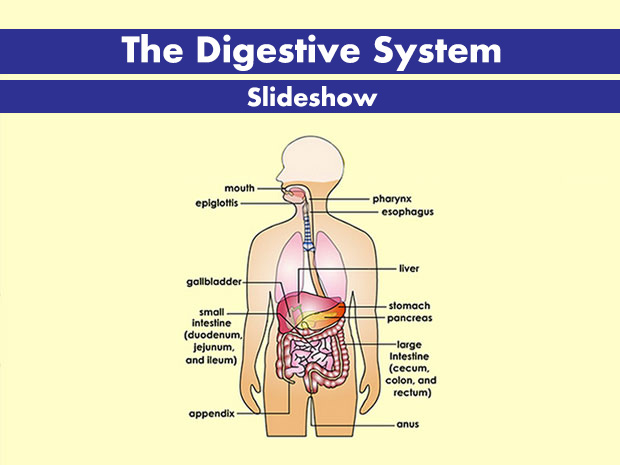
The Digestive System
The digestive system consists of the parts of the body that work together to turn food and liquids into the building blocks and fuel that the body needs.
Click through this slideshow to learn more about the digestive system.
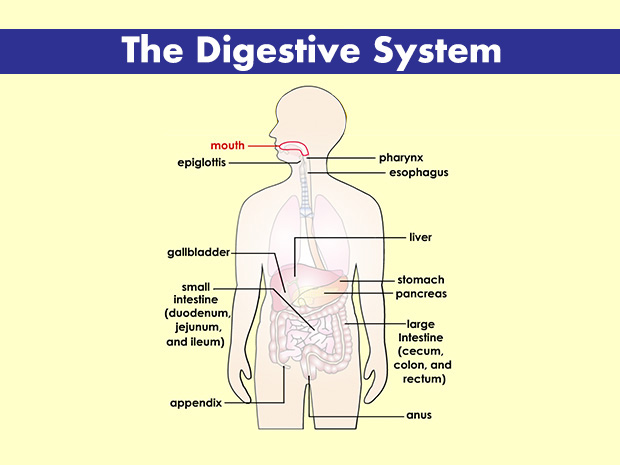
The Digestive System
Mouth
The mouth is where the digestive tract begins. Enzymes released into the mouth start the process of digestion.
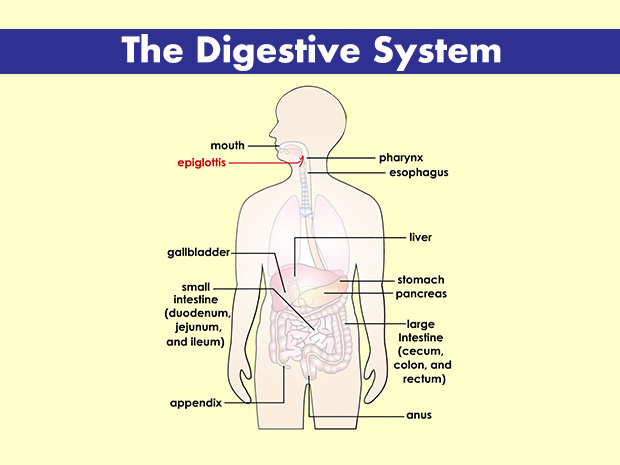
The Digestive System
Epiglottis
The epiglottis is a small piece of tissue that covers the opening of the larynx.
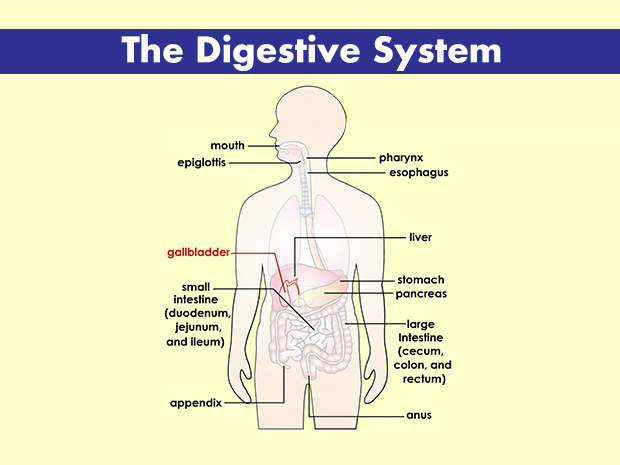
The Digestive System
Gallbladder
The gallbladder is a small pouch that stores bile. The gallbladder release bile into the duodenum to help digest fats in the food you eat.
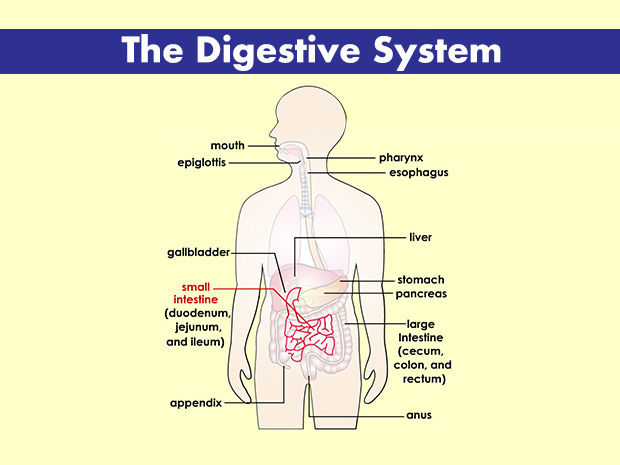
The Digestive System
Small Intestine
The small intestine is called small because of its width, not its length. It's actually much longer than the large intestine. The small and large intestines form one continuous tube.
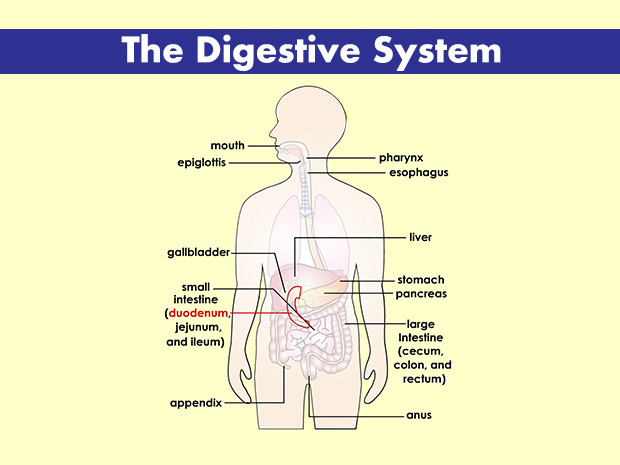
The Digestive System
Duodenum
The word duodeni is Latin and means "12 each." The duodenum, the first part of the small intestine, was thought to be as long as the width of 12 fingers.
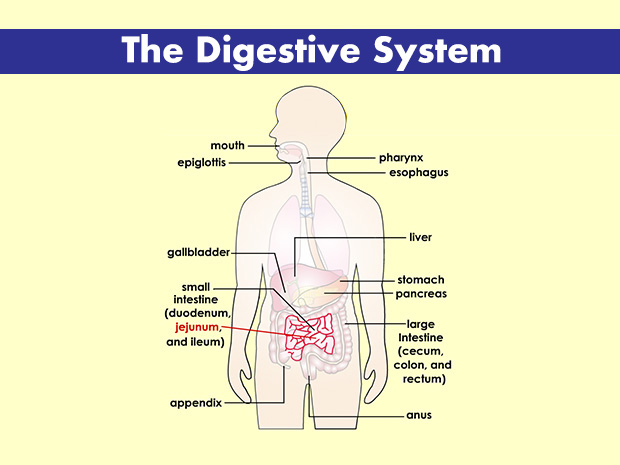
The Digestive System
Jejunum
The jejunum, the middle section of the small intestine, is about 5 to 8 feet (1.5 to 2.5 meters) long.

The Digestive System
Ileum
The ileum is the third and final section of the small intestine. It's also the longest, measuring 16 to 20 feet (5 to 6 meters) long.
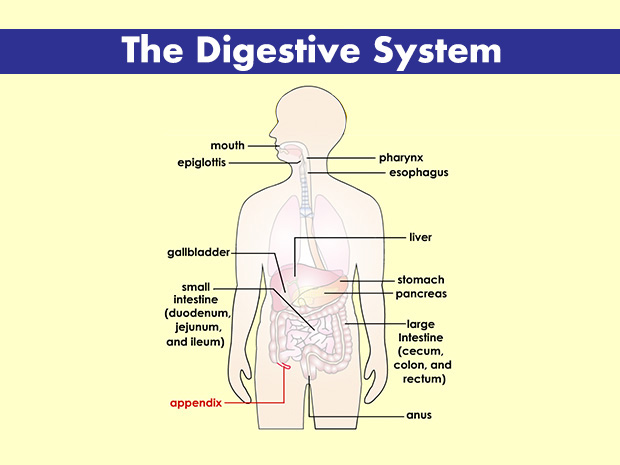
The Digestive System
Appendix
The appendix is attached to the cecum. If it becomes inflamed, this is called appendicitis.
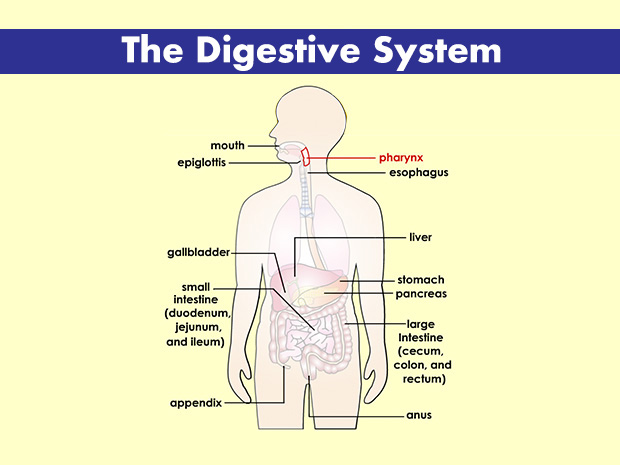
The Digestive System
Pharynx
Because both food and air move through it, the pharynx is part of both the respiratory and digestive systems.
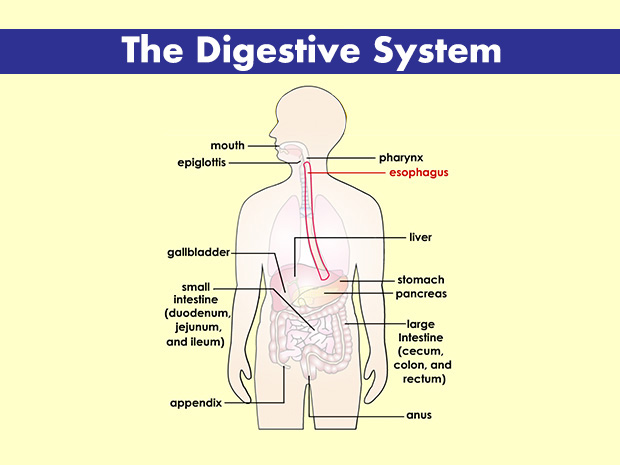
The Digestive System
Esophagus
The esophagus is a soft, muscular tube that moves food from the pharynx to the stomach.

The Digestive System
Liver
The liver is the body's largest internal organ. The liver performs many tasks, including storing energy and helping the body get rid of toxins.
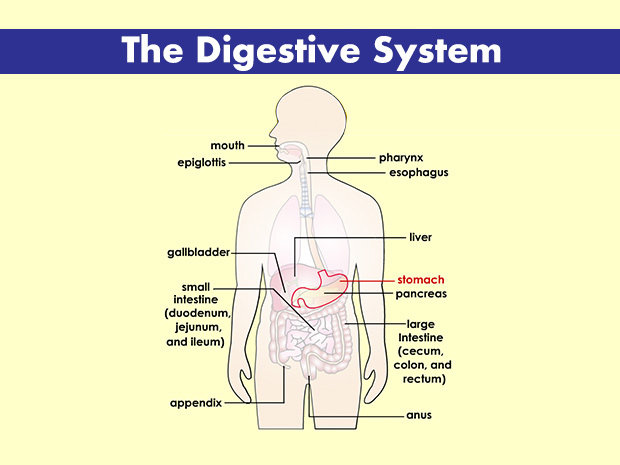
The Digestive System
Stomach
The stomach has a tough lining. It's able to hold up in the highly acidic environment needed to break down food.
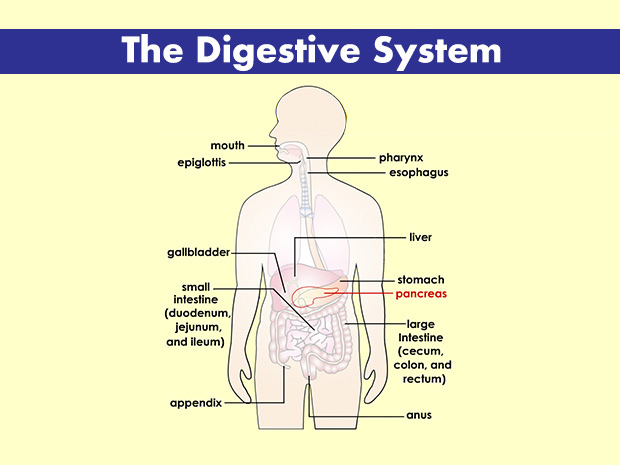
The Digestive System
Pancreas
The pancreas makes hormones (including insulin) to regulate the blood glucose level. It also makes enzymes that break down food in the intestines.
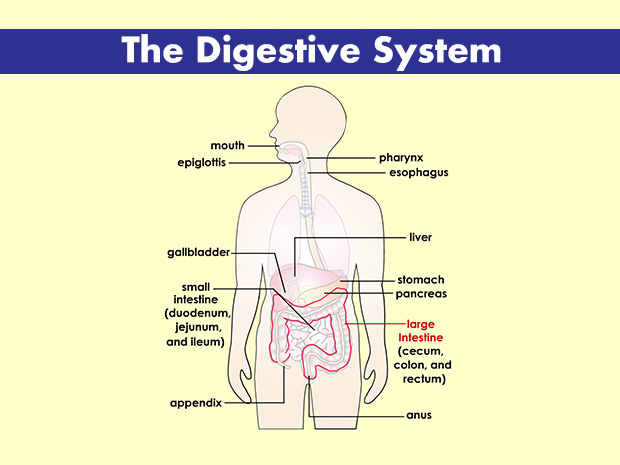
The Digestive System
Large Intestine
The large intestine consists of three parts: the cecum, the colon, and the rectum.
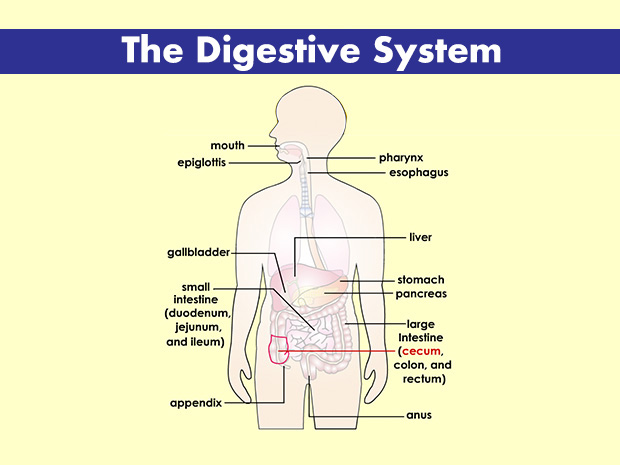
The Digestive System
Cecum
The cecum is the pouch‑like beginning of the large intestine.
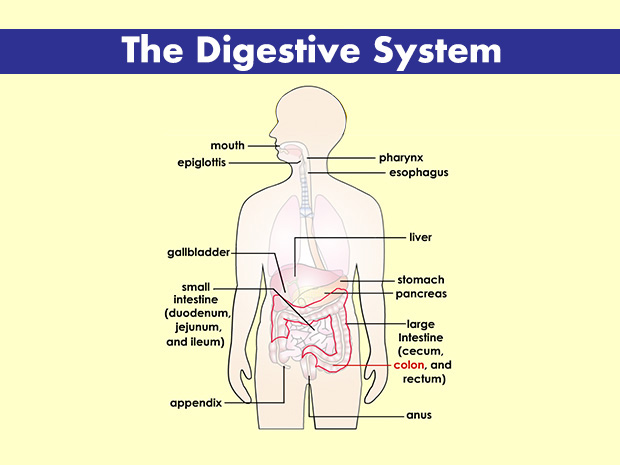
The Digestive System
Colon
The colon is the largest part of the large intestine and has three parts: the ascending colon, the transverse colon, and the descending colon.
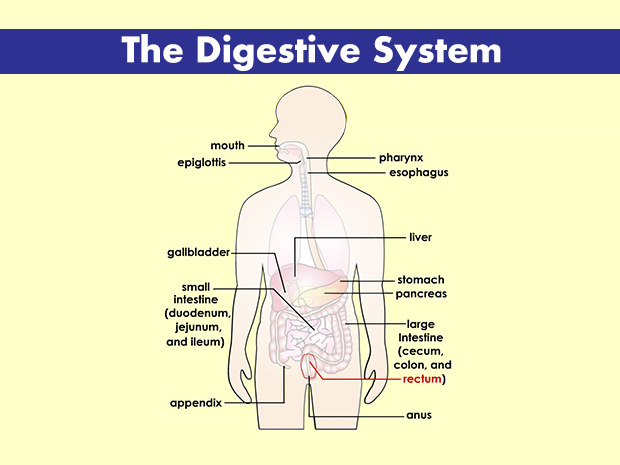
The Digestive System
Rectum
The rectum is the final 6 to 8 inches (15 to 20 centimeters) of the large intestine. It stores stool (poop) until it leaves the body.
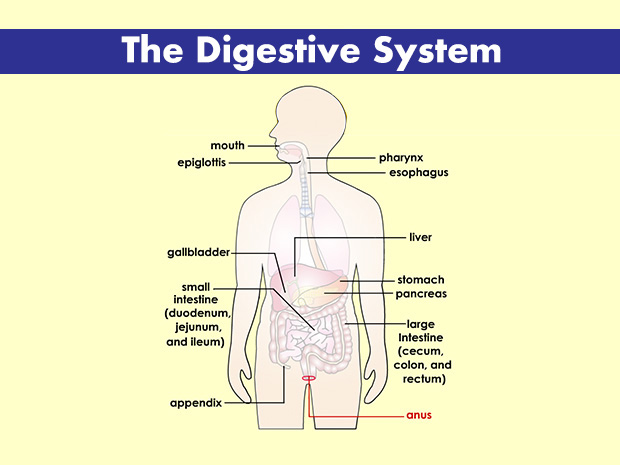
The Digestive System
Anus
The anus marks the exit point of the digestive tract; it's where poop leaves the body.
How Does the Digestion System Work?
Here’s how digestion happens:
The mouth: Digestion begins even before we taste food. When we see, smell, taste, or even imagine a tasty meal, our salivary glands (located in front of the ears, under the tongue, and near the lower jaw) begin making saliva (spit).
Teeth tear and chop the food. Spit moistens it for easy swallowing. A digestive enzyme in saliva called amylase (AH-meh-lace) starts to break down some carbohydrates (starches and sugars) in the food.
Muscles in the tongue and mouth work together to swallow the food and move it into the throat (pharynx). The pharynx (FAIR-inks) is a passageway for food and air. A soft flap of tissue called the epiglottis (ep-ih-GLAH-tus) closes over the windpipe when we swallow to keep food and liquid out of the lungs.
The esophagus: Food travels down a muscular tube in the chest called the esophagus (ih-SAH-fuh-gus). Waves of muscle contractions called peristalsis (per-uh-STALL-sus) force food down through the esophagus to the stomach. A person usually isn't aware of the muscle movements that push food through the digestive tract.
The stomach: At the end of the esophagus is a muscular ring or valve called a sphincter (SFINK-ter). The sphincter lets food enter the stomach, then squeezes shut to keep food and liquids from flowing back up into the esophagus. The stomach muscles churn and mix the food with digestive juices that have acids and enzymes. These juices help break up food into much smaller pieces.
By the time food is ready to leave the stomach, it has been turned into a thick liquid called chyme (kime). A small muscular valve called the pylorus (pie-LOR-is) controls when chyme is released into the small intestine.
The small intestine: The small intestine is where many nutrients (like protein, carbohydrates, and fats) get absorbed into the bloodstream. It has three parts:
- The duodenum (due-uh-DEE-num). This C-shaped first part is where enzymes from the pancreas and bile from the liver are added to the chyme.
- The jejunum (jih-JU-num). This coiled middle part further digests the chyme and absorbs nutrients.
- The ileum (IH-lee-um). The final section that leads into the large intestine absorbs nutrients, vitamin B12, and bile acids.
Millions of microscopic, finger-like projections called villi (VIH-lie) line the inside of the small intestine. The villi make lots of surface area for nutrients to get absorbed into the blood. Then blood brings the nutrients to the rest of the body.
While food works its way through the small intestine, three organs that are not part of the alimentary canal help the digestion process:
- The liver makes bile, which helps the body absorb fat. It’s located in the top right of the belly.
- The gallbladder stores bile until it is needed. It’s hidden just below the liver.
- The pancreas makes enzymes that help digest proteins, fats, and carbs. It’s found below the stomach.
Enzymes and bile travel through small pathways (called ducts) into the small intestine, where they help to break down food.
Undigested food and some water travels to the large intestine through a muscular ring called the ileocecal (ill-ee-oh-SEE-kul) valve. This valve prevents food from returning to the small intestine. By the time food reaches the large intestine, the work of absorbing nutrients is nearly finished.
The large intestine: The large intestine's main job is to remove water from the undigested matter and form solid waste (poop) to be excreted. The large intestine includes three parts:
- The cecum (SEE-kum) is the beginning of the large intestine. The appendix is a small, hollow, finger-like pouch that hangs off the end of the cecum. Doctors believe the appendix is left over from an earlier time in human evolution. Today it’s no longer needed to help with digestion.
- The colon extends from the cecum up the right side of the abdomen (the ascending colon), across the upper abdomen (transverse colon), and down the left side of the abdomen (descending colon). Then it connects to the rectum.
- The rectum is where poop is stored until it leaves the digestive system through the anus as a bowel movement.
It can take days for food to fully pass through the digestive system.

© 1995- The Nemours Foundation. KidsHealth® is a registered trademark of The Nemours Foundation. All rights reserved.
Images sourced by The Nemours Foundation and Getty Images.
Humana Healthy Horizons in Ohio
- Humana Healthy Horizons
- Humana Healthy Horizons Extras
- Member Support
- Care management
- Caregiver resources
- Child well-being
- Disease management
- Documents and forms
- Enrollment
- Grievances and appeals
- Health and wellness
- KidsHealth
- Member Handbook
- New Member Resources
- News and alerts
- OhioRISE Plan
- Pregnancy outcomes
- Tobacco cessation
- Why Humana
- Your primary care provider
- For Providers
- Contact us
- Accessibility
- Humana Healthy Horizons
- Humana Healthy Horizons Extras
- Member Support
- Care management
- Caregiver resources
- Child well-being
- Disease management
- Documents and forms
- Enrollment
- Grievances and appeals
- Health and wellness
- KidsHealth
- Member Handbook
- New Member Resources
- News and alerts
- OhioRISE Plan
- Pregnancy outcomes
- Tobacco cessation
- Why Humana
- Your primary care provider
- For Providers
- Contact us
- Accessibility